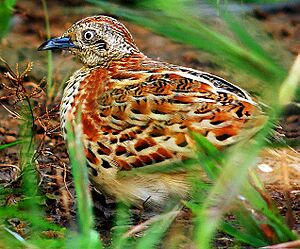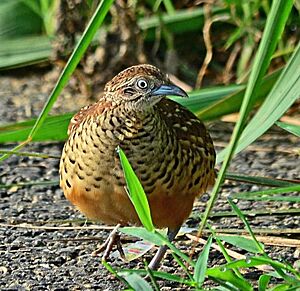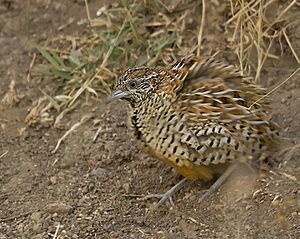Barred buttonquail facts for kids
Quick facts for kids Barred buttonquail |
|
|---|---|
 |
|
| Conservation status | |
| Scientific classification | |
| Genus: |
Turnix
|
| Species: |
suscitator
|
The barred buttonquail (Turnix suscitator) is a small bird. It is part of a family called buttonquails. These birds look like true quails, but they are not closely related. This species lives in many places across Asia. You can find them from India to south China, Indonesia, and the Philippines.
Contents
About the Barred Buttonquail
How it Got its Name
The barred buttonquail was first officially described in 1789. A German scientist named Johann Friedrich Gmelin gave it its scientific name. He called it Tetrao suscitator. Later, it was placed in the group Turnix. The name suscitator comes from Latin. It means "awakening."
There are many different types, or subspecies, of barred buttonquails. Scientists recognize sixteen of these subspecies. Each one might look a little different or live in a specific area.
What it Looks Like
The barred buttonquail is a small bird. It has reddish-brown feathers on its back. Its belly is a mix of rusty and light brown colors. Its chin, throat, and chest have thin black stripes.
The female bird is usually bigger and has brighter colors. Her throat and the middle of her chest are black. Both males and females have blue-grey beaks and legs. Their eyes are yellowish-white. When they fly, you might see light brown patches on their wings.
One special thing about buttonquails is that they don't have a back toe. This helps tell them apart from true quails. These birds often live in pairs. They make calls that sound like a motorcycle, "drr-r-r-r-r-r". They also make a loud "hoon-hoon-hoon" sound.
Where it Lives
You can find the barred buttonquail in many parts of India. They live in areas up to about 2500 meters high in the Himalayas. They also live in Sri Lanka, Bangladesh, Burma, Indonesia, the Philippines, and most of Southeast Asia.
These birds live in many different places. They like scrub jungles, light forests, and farmlands. They usually avoid very dense forests or deserts.
How it Raises its Young
Barred buttonquails have an interesting way of raising families. The female bird is the one who finds a mate. She is also the one who builds the nest on the ground. She will even fight with other females to get a male partner. She makes a loud drumming sound to challenge other females. This sound also tells a male that she is ready to mate.
After the female lays her eggs, the male takes over. He sits on the eggs to keep them warm until they hatch. He also takes care of the young birds once they are born. The baby birds can run around as soon as they hatch. The female bird then goes off to find another mate. She might do this several times. They can breed almost all year round.
Their nest is a simple scrape in the ground. It is lined with grass and often hidden by plants. A female usually lays 3 or 4 eggs. The eggs are grayish-white with reddish-brown or blackish-purple spots.
Conservation Status
The barred buttonquail is a common bird. It lives in a very large area. Because of this, scientists say it is of "Least Concern". This means it is not currently in danger of disappearing. Its status is listed on the IUCN Red List of threatened species.






